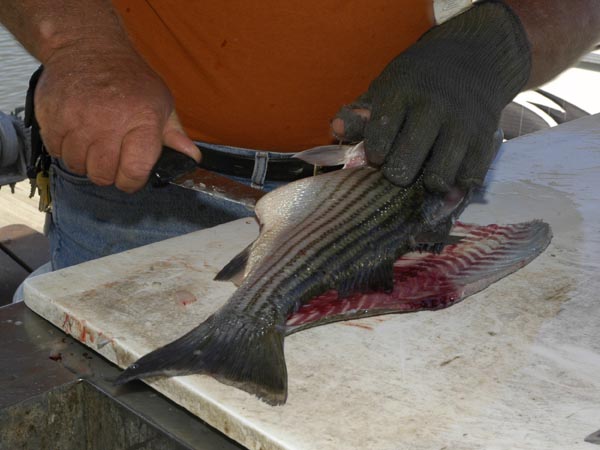Activity / How-To
How To Fillet A Fish

By Ken Kurzawski
Get your catch ready for the table.
Should today's conservation-minded anglers catch fish to eat? The answer is an emphatic yes! Fishing regulations for both fresh water and salt water are designed to allow some harvest, provided, of course, that anglers adhere to length and bag limits.
Filleting is one of the most popular ways to prepare fish for cooking. Filleting produces two edible portions of fish flesh (called fillets) without bones or skin. A sharp knife designed for filleting is a must.
To keep fish edible, they must be properly handled from the moment they are caught. Fish should be kept on ice if they can't be kept alive before being filleted. If that will be for an extended period (for example, overnight), the fish should have their entrails and gills removed to reduce spoilage.
To fillet a fish, start by laying the fish on its side on a flat surface. Position your knife behind the fish's gill cover, holding the knife handle at the top or dorsal part of the fish. Make your first cut behind the gill cover through the skin and flesh cutting down to but not through the backbone.
Next, position the blade parallel to the dorsal fin and between the bones and flesh. Work the knife toward the tail. The point of the knife should extend to but not through the rib cage. Keeping the blade flat and tight against the bones, make even, sweeping strokes to separate the flesh from the bones. Keep working toward the tail until your knife clears the rib cage. At this point, the knife can be pushed through the fish. The point will extend out of the fish near the anal vent. Continue cutting along the bone to but not through the tail. Spread the cut open and work the blade around and over the ribs, freeing the flesh from the rib cage.
Now, for the tricky part! The fillet should be free from all bones and attached to the fish by just a small section of skin near the tail. Flip the fish over so the skin side of the cut portion is on the bottom. At the spot where the fillet is attached to the tail, slide the knife under the flesh but not through the skin. Holding the tail with one hand, work the knife along the skin while pulling the tail in the opposite direction. Cut until the fillet is free from the skin. Repeat the above steps for the other side of the fish. The result will be two skinless, boneless fillets ready for your favorite recipe.
Of course, there's more than one way to fillet fish. If you wish to keep the skin on the fillet, just cut through the skin where it is attached to the tail. Rather than cutting the flesh from around the rib cage, you can cut through the rib bones where they are attached to the spine. If you use this method, the rib bones should be cut off the fillet before cooking.
Eating fish has always been and should remain a part of the experience of going fishing. Lots of great-tasting recipes for fish can be found, and eating fish is good for you, too.
———This article appeared in the December 2002 issue of Texas Parks & Wildlife. If you’d like to read more articles like this or subscribe to the magazine, visit www.tpwmagazine.com/.
 Texas Parks and Wildlife Department, 4200 Smith School Road, Austin, TX 78744
Texas Parks and Wildlife Department, 4200 Smith School Road, Austin, TX 78744


